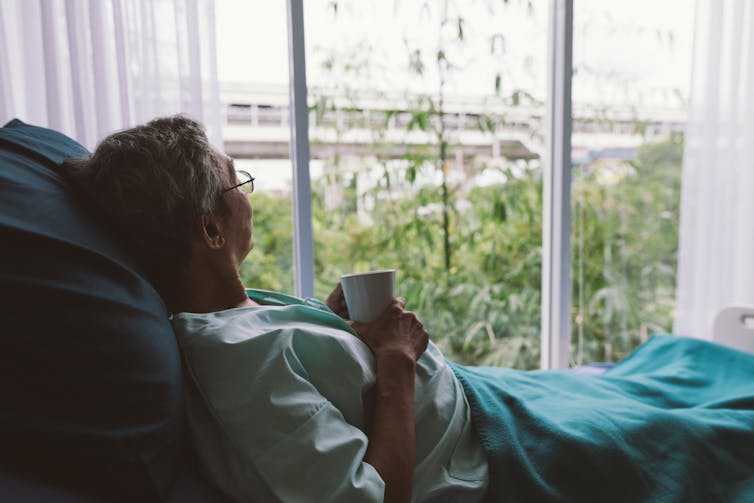
Most people might not want to commit a lot time to occupied with their demise. Nonetheless, it’s an unlucky incontrovertible fact that the entry level into experiences or conversations round demise and end-of-life care can occur abruptly.
An sudden demise or a terminal prognosis can go away people ill-equipped to navigate what typically appears like uncharted territory of navigating end-of-life care, bereavement and grief.
The difficult realities surrounding end-of-life care are particularly tough for older people experiencing homelessness. For these older adults, intersectional and compounding experiences of oppression, resembling poverty, racial disparities and ageism, create limitations to accessing hospice care.
Misconceptions about hospice care
The need for end-of-life and palliative companies for unhoused people will seemingly proceed to develop because the inhabitants experiencing homelessness grows and ages.
At the moment solely 16 to 30 per cent of Canadians have access to hospice and palliative care companies, and 34 per cent of Canadians are not clear on who is eligible or who ought to make the most of hospice companies. In response, Might 7-13 marks Nationwide Hospice Palliative Care week, which is geared toward growing consciousness about hospice care in Canada.
 Hospice care is offered in numerous settings, together with in sufferers’ properties. (Shutterstock)
Hospice care is offered in numerous settings, together with in sufferers’ properties. (Shutterstock)
The misconceptions about hospice care have had a direct affect on the engagement of companies for the general public, but in addition for Indigenous communities and for older adults experiencing homelessness.
Efforts to improve consciousness about hospice typically neglect probably the most weak populations. Future efforts should merge schooling and consciousness with intersectionality, which takes into consideration the intersections of inequities that affect unhoused older adults.
Hospice care focuses on addressing the complete spectrum of a affected person’s bodily, emotional, social and non secular experiences and wants. A typical false impression is that hospice is completely a location or place the place people go to die. Opposite to this notion, hospice is a service that’s offered in numerous settings together with inside one’s residence, long-term care amenities, hospice centres or inside a hospital.
Finish-of-life care
Whereas many Canadians want to die at residence, older people experiencing homelessness do not need the identical alternatives for end-of-life care choices, and in consequence many unhoused older people die within the hospital or institutional settings.
Household and pals typically play an important position in caring and advocating for a beloved one throughout their end-of-life course of. We are able to solely hope to have family members by our aspect throughout these ultimate phases; nonetheless, that isn’t the truth for a lot of unhoused group members who do not need the choice to die at residence with family members.
Older people experiencing homelessness are particularly weak due to restricted household or social help networks. Lack of social help can lead to unhoused older people feeling remoted and fearful about dying alone or anonymously.
A core focus of palliative care is on easing signs and growing high quality of life for people who have a severe or continual sickness, and not solely for these who are dying. Palliative care is usually a priceless type of well being care for older people experiencing homelessness, as it may supply a tailor-made strategy to managing a number of continual or terminal sicknesses, which are prevalent amongst unhoused older people.
Palliative care that takes place in a hospital setting can lower end-of-life care prices by almost 50 per cent by lowering intensive care unit admissions and pointless intervention procedures.
We imagine it’s priceless to contemplate that if end-of-life care prices have been decreased through the use of palliative care practices, the fee financial savings might be used to fund companies that instantly help unhoused older adults, resembling elevated reasonably priced housing choices.
Getting old in the suitable place
As members of the Getting old within the Proper Place challenge analysis crew at Simon Fraser College, we are working to better perceive what getting old and dying in the suitable place means to unhoused older adults in two websites offering end-of-life care in Vancouver.
Might’s Place Hospice, which is within the Downtown Eastside of Vancouver, gives end-of-life care for group members in that a part of town. Might’s Place has created a communal, home-like atmosphere with non-public rooms, meals offered thrice a day, 24-hour nursing care, a smoking lounge and household gathering house.
 Palliative care that takes place in a hospital setting can lower end-of-life care prices by almost 50 per cent. (Shutterstock)
Palliative care that takes place in a hospital setting can lower end-of-life care prices by almost 50 per cent. (Shutterstock)
One other inpatient hospice setting in Vancouver is Cottage Hospice, situated in a 1924 heritage constructing. Sufferers have a view of the North Shore mountains and are shut to the water. Cottage Hospice and Might’s place present the identical varieties of hospice palliative care help, and each care for older sufferers experiencing homelessness, however serve completely different populations based mostly on their location and setting, demonstrating that hospice and palliative care just isn’t a one-size-fits all strategy.
The Getting old within the Proper Place challenge captures the views and lived experiences of older people experiencing homelessness by integrating photovoice interview analysis strategies in addition to knowledge assortment strategies that centered on the hospice setting, the neighbourhood, and experiences of employees who work to help unhoused older people. Photovoice is a technique utilized in community-based analysis wherein contributors use photograph taking and storytelling to doc their very own views and experiences.
Within the Vancouver space the place we work — also referred to as the land that belongs to the Skwxwú7mesh (Squamish), xʷməθkwəy̓əm (Musqueam) and Səl̓ílwətaʔ/Selilwitulh (Tsleil-Waututh) people — and all through the province, colonization and colonial medical fashions have had lasting and detrimental impacts on Indigenous data and conventional practices round demise and dying for First Nation communities.
One instance of those impacts is that present hospice fashions might not mirror culturally related care fashions. Hospice organizations all through B.C. ought to prioritize growing coverage and apply for Indigenous teams to guarantee security and culturally related care are applied. Guaranteeing accessibility to hospice and palliative care is one step in direction of dismantling these limitations for Indigenous populations.
B.C. can flip to the Palliative Schooling and Look after the Homeless (PEACH) service fostered by Inside Metropolis Well being Associates (ICHA) in Toronto for example. PEACH is taking a various and modern strategy to offering palliative care among the many homeless and weak populations, together with Indigenous communities and older adults. Modern and culturally delicate companies resembling these, are a step in the suitable route to offering better end-of-life care to older adults experiencing homelessness.
It’s essential that we make hospice and palliative care companies obtainable to all group members, particularly with the getting old inhabitants and an improve in continual sicknesses all through Canada.
As well as to supporting group members, hospice and palliative care ought to focus efforts on tailoring approaches to present culturally related care, growing employees schooling concerning the lived experiences of older people experiencing homelessness, and creating protected and accessible companies in B.C. for marginalized communities.
We should actively dismantle misconceptions concerning the position of hospice and palliative care by schooling and consciousness to facilitate acceptable service supply and use for numerous populations.







